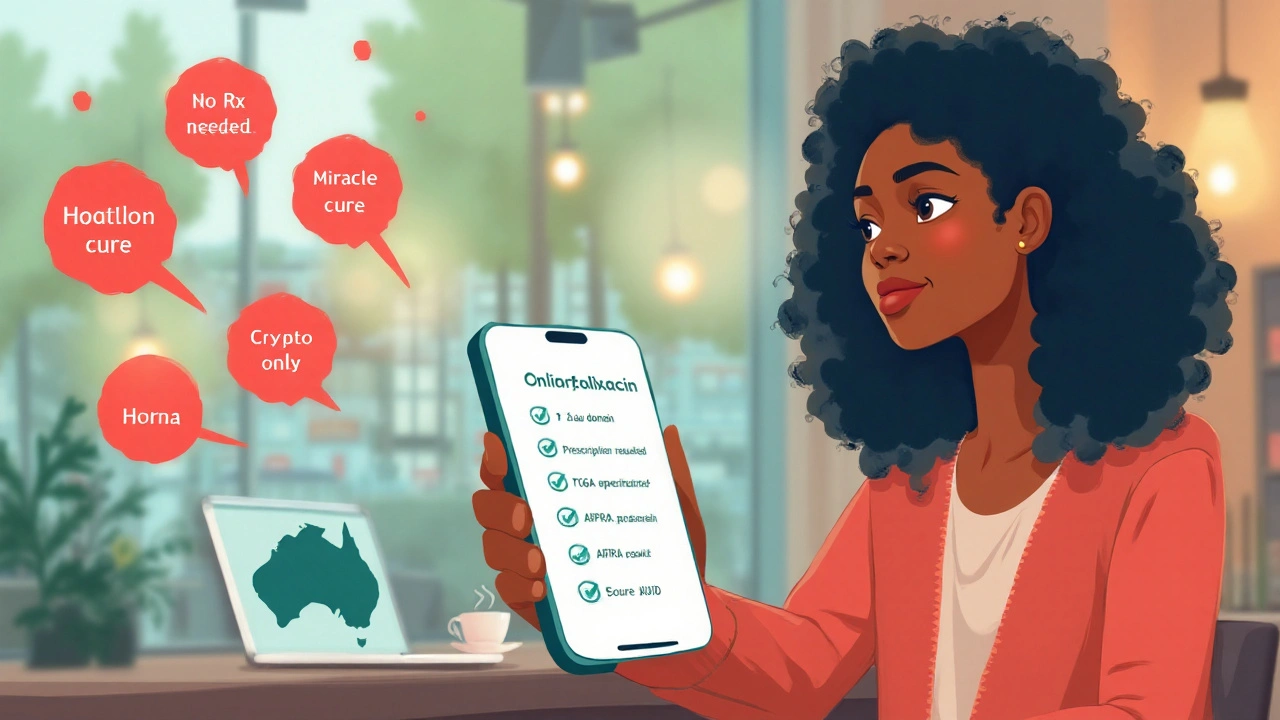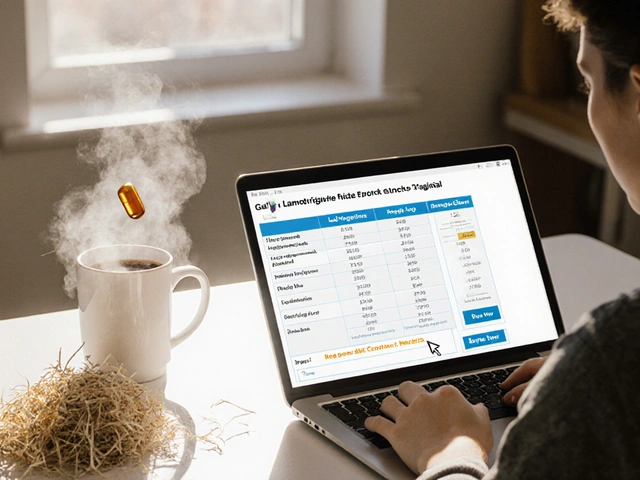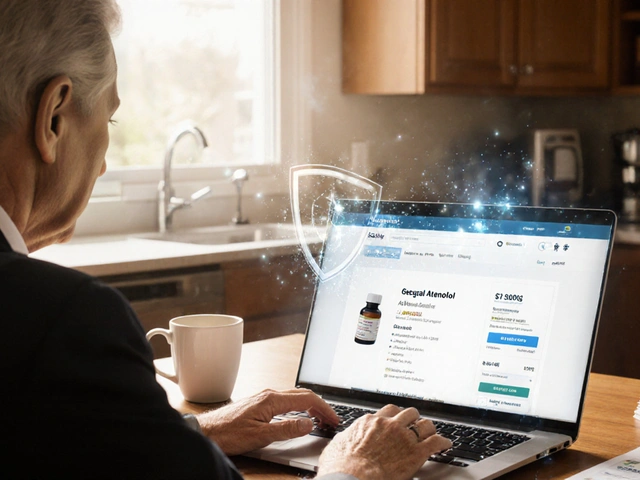You want the lowest price on generic ciprofloxacin, and you want it delivered. Here’s the catch: in Australia, ciprofloxacin is prescription-only. The safe, legal path exists, and yes-you can still save real money. I live in Melbourne, and like most people juggling work, family, and a golden retriever who treats every courier like a sworn enemy, I prefer simple, fast, and legit. If you’re trying to buy generic cipro online without getting scammed or breaking the law, this guide gives you the exact steps, price ranges you should expect in 2025, and the red flags that matter.
What “cheap, legal, and safe” really looks like for ciprofloxacin online in Australia (2025)
First, set expectations. Ciprofloxacin (often called “cipro”) is a fluoroquinolone antibiotic. In Australia, it’s Schedule 4-so you need a valid prescription from an Australian-registered prescriber, whether you order online or walk into a pharmacy. Legit Australian pharmacies must require that script. If a site offers ciprofloxacin with “no prescription needed,” back away. Those sites commonly sell substandard or counterfeit medicines. That’s not just a waste of money-it can be dangerous.
Why the strict rules? Safety and resistance. The Therapeutic Goods Administration (TGA) has repeated safety notices on fluoroquinolones due to rare but serious side effects like tendon rupture, peripheral neuropathy, and effects on the nervous system and heart. Because of these risks-and antibiotic resistance-Australian guidelines usually reserve ciprofloxacin for specific infections where benefits outweigh risks. Translation: your doctor may choose a different first-line antibiotic for common issues (for example, nitrofurantoin or trimethoprim for many uncomplicated UTIs). That’s not a sales tactic-it’s evidence-based care.
So what does “cheap” mean when you do it right? In 2025, generic ciprofloxacin is widely available and competitively priced in Australia, especially online. You can reduce costs by using the PBS (where applicable), concession entitlements, and price-matching. You’ll see private prices that often beat high-street shelves, plus free shipping thresholds. But “cheap” without a prescription isn’t legal here. The sweet spot is safe + legal + fair price.
Here’s how to think about the job you’re really trying to get done:
- Get a valid prescription quickly (ideally the same day).
- Choose a verified, Australian-based online pharmacy.
- Pay a fair 2025 price (know the ranges so you can spot real deals).
- Avoid counterfeit or unsafe sources.
- Know the big safety rules, interactions, and what to ask your doctor.
Step-by-step: How to get a valid script and order ciprofloxacin from a verified online pharmacy
If you’ve never ordered a prescription medicine online in Australia, here’s the no-drama path I recommend to friends and family.
- Talk to a GP or telehealth doctor. Explain your symptoms and history. Ciprofloxacin isn’t first-line for many infections; your doctor will decide what’s appropriate. If ciprofloxacin is indicated, ask for an eScript (QR/token) for fastest processing. Sources for care and advice include your regular GP, accredited telehealth services, or calling Healthdirect for guidance.
- Check your PBS status. If your prescription is for a PBS-listed indication, you’ll pay the PBS co‑payment rather than the private price. In 2025, general patient co‑payments are typically around the low $30s and concessional around the high $7s. These amounts are indexed annually-your pharmacy will confirm the exact figure at checkout.
- Pick a verified Australian online pharmacy. Look for: an Australian Business Number (ABN), an Australian physical address, AHPRA-registered pharmacists, secure checkout, and a requirement to upload or enter an eScript token. Live chat or a phone line to speak to a pharmacist is a strong positive. No prescription required? That’s a hard no.
- Upload your eScript and confirm the exact product. Ciprofloxacin comes in multiple strengths (commonly 250 mg, 500 mg, 750 mg) and sometimes liquid forms. Double-check strength, pack size, and directions match your prescription. If the pharmacy suggests a brand substitution, that’s normal with generics-just ensure the active ingredient and strength are the same.
- Compare final prices and shipping. Shortlist 2-3 pharmacies and compare the total landed price: medicine + dispensing fee + shipping. Many offer free standard shipping over a spend threshold. Express post can be worth it if you need it quickly.
- Place the order and keep the receipt. Most pharmacies will dispense the same day if the eScript lands during business hours. In metro areas, standard shipping is usually 1-3 business days; regional may take longer. If anything looks off, ask to speak with the pharmacist-completely normal, and encouraged.
Pro tips from the “I’ve done this a lot” file:
- If stock is low, ask whether they have another TGA-approved generic brand at the same strength. It’s often just a label change.
- Ordering after the courier cut-off? Choose Express-it often saves you a full day.
- Medicines can’t be returned once supplied, so triple-check details before you pay.
- Set a reminder: complete the full course exactly as prescribed. Stopping early invites relapse and resistance.

Prices, deals, and ways to pay less without cutting corners
What counts as a fair price in 2025? Private prices for generic ciprofloxacin have stayed competitive. PBS co‑payments cap the out-of-pocket for eligible scripts. Below is a realistic range so you can spot a deal without falling for a fake.
| Formulation (generic) | Common pack size | Indicative private price (AU$) | Typical PBS co‑payment (AU$) | Notes |
|---|---|---|---|---|
| Ciprofloxacin 250 mg tablets | 10-14 tablets | $8-$18 | General: ~low $30s; Concession: ~$7-$8 | PBS only for certain indications; pricing changes with indexation |
| Ciprofloxacin 500 mg tablets | 10 tablets | $9-$22 | General: ~low $30s; Concession: ~$7-$8 | Most-ordered strength in many adult scripts |
| Ciprofloxacin 750 mg tablets | 10 tablets | $12-$28 | General: ~low $30s; Concession: ~$7-$8 | Used for certain infections per prescriber advice |
| Ciprofloxacin oral suspension 250 mg/5 mL | 100 mL | $20-$45 | Varies by indication | Ask pharmacist about storage and expiry after mixing |
| Ciprofloxacin eye/ear drops 0.3% | 5-10 mL | $6-$16 | Varies | Different usage and dosing-don’t substitute tablets with drops |
| Shipping (standard) | - | $0-$9 | - | Often free over a spend threshold; Express typically $9-$15 |
Ways to keep costs down without risking safety:
- Use the PBS where eligible. If your script is PBS-listed, you’ll pay the co‑payment rather than the private price. Check your prescription’s indication and ask the pharmacist to confirm.
- Ask for a generic brand. In Australia, all generics must meet TGA standards for quality and bioequivalence. If your doctor allows “brand substitution,” the pharmacy can supply a cheaper equivalent.
- Compare 2-3 online pharmacies. Look at the total cost: medicine + dispensing + shipping. Many offer free standard shipping if your cart passes a threshold (often $50-$99).
- Price-match. Some large pharmacy groups price-match competitors on identical items. Screenshot the offer and ask.
- Use your concession or Safety Net. Concession cards lower co‑payments, and the PBS Safety Net can reduce costs further once you hit the annual threshold.
What “too cheap” looks like: rock-bottom prices with slogans like “no prescription, worldwide shipping, bulk antibiotics” are a neon sign for counterfeits. The pills may be under-dosed (feeding resistance) or contaminated. Saving a few dollars isn’t worth a hospital visit.
Safety, red flags, and quick answers (FAQ + next steps)
Antibiotics aren’t like vitamin C. Ciprofloxacin has specific safety issues that matter. This isn’t to scare you; it’s to help you make good decisions and know what to ask your doctor.
Serious risks and who needs extra caution (summarised from TGA safety advice and standard prescribing references):
- Tendons, nerves, brain, heart: Rare but serious reactions can include tendonitis/tendon rupture (especially Achilles), peripheral neuropathy (tingling, pain, weakness), seizures/CNS effects, and QT prolongation (heart rhythm issues). Stop the medicine and seek urgent care if you get sudden tendon pain or swelling, pins and needles, new weakness, severe headaches, palpitations, fainting, or confusion.
- Higher risk groups: Over 60, those on systemic corticosteroids (like prednisolone), organ transplant recipients, people with known aneurysm, or certain heart rhythm problems. Tell your doctor if any apply to you.
- Pregnancy and breastfeeding: Not usually first choice. Your prescriber will weigh risks and benefits based on your situation.
- Children and adolescents: Specialist advice is common; it’s not a routine first-line option for kids unless specifically indicated.
Important interactions and how to avoid them:
- Antacids, iron, calcium, zinc, dairy: These can bind ciprofloxacin and block absorption. Take cipro at least 2 hours before or 4-6 hours after these.
- Tizanidine: Contraindicated with ciprofloxacin due to dangerous increases in tizanidine levels.
- Warfarin and other anticoagulants: Cipro can increase bleeding risk; you may need closer INR checks.
- Theophylline and caffeine: Ciprofloxacin can raise levels; watch for side effects.
- Drugs that prolong QT: Extra caution if you’re on certain antiarrhythmics or have existing QT issues.
Smart usage rules that save you headaches later:
- Take exactly as prescribed, at evenly spaced times, and finish the full course.
- Hydrate well. Avoid excessive sun/solarium-photosensitivity is a thing.
- Don’t share antibiotics and don’t use leftovers for a “similar” infection. That’s how resistance wins.
How to verify a pharmacy is real (quick checklist):
- Requires a valid Australian prescription or eScript token.
- Lists an Australian address and ABN, plus AHPRA registration details for pharmacists.
- Lets you speak with a pharmacist for counselling.
- Has clear privacy and returns policies (note: medicines generally aren’t returnable).
- Secure checkout (https), normal payment methods (no crypto-only setups).
- Prices are competitive but not unbelievably low.
Red flags worth running from:
- “No prescription required” or “doctor-free antibiotics.”
- Bulk “antibiotic packs” for every illness.
- No Australian contact details or a fake address if you map it.
- Only accepts wire transfers, crypto, or gift cards.
- No pharmacist consultation, no dispensing label, no batch/expiry information.
FAQ-fast answers to the questions you’re likely asking:
- Can I legally buy ciprofloxacin online in Australia? Yes, with a valid Australian prescription. The pharmacy must verify it before dispensing.
- Do I really need a prescription? Yes. Ciprofloxacin is Schedule 4. Sites selling without one are not compliant and risk your health.
- How fast can I get it? If you have an eScript, many online pharmacies dispense same business day; metro shipping is often 1-3 business days, with Express usually next business day.
- What if the pharmacy is out of my brand? Ask for an equivalent TGA-approved generic at the same strength. It’s normal and safe.
- Is ciprofloxacin the right antibiotic for a UTI? Not always. For many uncomplicated UTIs, guidelines prefer alternatives. Your doctor will choose based on your history, local resistance, and any allergies.
- How much should I pay? Private prices often range roughly $8-$28 depending on strength and pack size, plus shipping. PBS co‑payments cap out-of-pocket when applicable.
- What if I’m on warfarin? Tell your doctor and pharmacist; you may need INR monitoring during and after the course.
- I took an antacid-now what? Separate dosing: take ciprofloxacin at least 2 hours before or 4-6 hours after antacids, iron, or calcium-rich supplements/foods.
- What side effects require urgent care? Sudden tendon pain/swelling, severe rash, tingling/weakness, seizures, palpitations/fainting, or severe persistent diarrhea.
Next steps-choose your path based on where you are right now:
- No prescription yet, symptoms are mild: Book your GP or a reputable telehealth consult today. If ciprofloxacin isn’t indicated, you’ll likely get a safer first-line option.
- No prescription yet, symptoms are severe (fever, flank pain, vomiting, confusion): Seek same-day in-person care or emergency care-don’t wait for an online order.
- Prescription in hand (eScript): Shortlist 2-3 Australian online pharmacies, compare total landed prices, and order before the daily cut-off. Choose Express if timing matters.
- Found a “too good to be true” site: Don’t enter card details. If they offer antibiotics without a prescription, close the tab.
- Price still feels high: Ask for generic substitution, check PBS eligibility, apply any concession, and compare shipping thresholds. Consider click-and-collect if a local partner store offers it.
- Allergic to quinolones or unsure: Tell your doctor-there are other options. Never self-start an old antibiotic “just in case.”
A quick word on credibility: The safety points above align with public guidance from the TGA and standard Australian prescribing references; PBS costs and eligibility come from the Australian Government Department of Health and Aged Care. For symptom triage, Healthdirect is a reliable starting point. If you’re outside Australia, look to your national regulator (for example, FDA in the US, MHRA in the UK) and verified pharmacy programs when buying online.
You want it cheap. You also want it to work-and not cause avoidable harm. Stick to the legal route, compare like-for-like, and use your pharmacist as a guide. That’s how you save money without risking your health-or a headache from a delivery that never arrives. Now if only Sammy would stop barking at the postie.






Mark Haycox
August 26, 2025 AT 12:20This is simple: don’t cut corners with prescription antibiotics.
Ciprofloxacin is useful for certain infections, but the prescription requirement exists for a reason - safety and resistance. If someone’s selling it with no script, that’s where the risk lives, not in the pharmacy checkout. Look for an ABN, AHPRA info, and an actual Australian address before you hand over money. Cheap overseas pills often mean unknown ingredients and unpredictable dosing, and that’s not worth the savings.
Also, watch the interactions - mixing cipro with things like some antacids or tizanidine is a guaranteed mess. Stick with verified telehealth or your GP, get the eScript, and move on with your life.
Gena Thornton
August 27, 2025 AT 05:00Good, practical checklist here; a few extra, concrete tips that actually save time and money.
First, when you book a telehealth consult, mention up front that you want an eScript if a prescription is needed - that speeds the whole chain. When comparing pharmacies, screenshot the eScript token page or note the token expiry so you don’t lose it while shopping around. Use the PBS lookup on the Department of Health site to confirm whether your indication is listed; if it is, make sure to claim the co‑payment at checkout so you’re not overpaying.
Also, if you or someone in your household takes warfarin, tell the pharmacist clearly and ask them to note it on the dispensing label; pharmacists will flag the need for INR monitoring and can counsel on bleeding signs. Finally, keep receipts and the dispensing label until the course is complete - that info matters if there’s any adverse event later.
Lynnett Winget
August 27, 2025 AT 16:06Nice practical addendum to the prescription flow that actually helps people dodge the stupid pitfalls.
When a pharmacy offers a different generic brand, don’t panic - generics approved by the TGA meet bioequivalence standards, so the active ingredient should perform the same, even if the tablet looks different. Keep the leaflet and the pack in case you need batch/expiry info later; that little detail saved me once when a recall hit and I was able to check my batch straight away.
Also, store oral suspensions in the fridge only if the label says so, and note the expiry after reconstitution - they usually become short-lived once mixed. Little practical things like that keep antibiotics effective and avoid waste.
Amy Hamilton
August 28, 2025 AT 19:53Good emphasis on safety. It’s important to treat antibiotics like powerful tools, not pantry items.
Resistance is communal - using the right drug, right dose, and finishing the course protects not just you but everyone else by reducing selection pressure for resistant strains. The TGA guidance on fluoroquinolones exists because of real harms; those tendon and nerve issues are rare but can be life-changing if dismissed. If you’re in a higher‑risk group, insist that your prescriber documents the risk/benefit discussion so there’s a clear record.
Finally, be firm with pharmacies about counseling - you have the right to a pharmacist consultation, and that conversation often prevents misuse and interactions.
Lewis Lambert
August 29, 2025 AT 23:40Courier drama is real - package tracking and signature options can turn a chaotic drop-off into a smooth delivery.
Choose a pharmacy that offers SMS/email tracking updates and allows a signature requirement or safe drop preferences; if you’ve got a dog that treats couriers like intruders, choose to pick up in-store or hold at the depot so the parcel doesn’t get munched or stolen.
Also, ask for discreet packaging if that matters to you - it’s a small ask and often free, but it reduces the temptation for porch pirates.
Tamara de Vries
August 31, 2025 AT 03:26Saved me once, thanks.
Jordan Schwartz
September 4, 2025 AT 18:33Couple of clinical‑practice points that might help folks avoid trouble when they start the script.
Timing with minerals and antacids matters a lot - keep at least a 2 hour gap before, or 4–6 hours after, when taking calcium, iron, zinc or antacid preparations. For patients on warfarin, expect the pharmacist to recommend extra INR checks during the course and maybe a dose adjustment; that’s standard and prevents bleeding complications. Tizanidine is an absolute contraindication with ciprofloxacin because the antibiotic inhibits metabolism and can cause dangerously high muscle relaxation and low blood pressure, so flag any muscle relaxants on your med list.
For caffeine and theophylline, expect increased levels - watch for jitteriness, palpitations, or nausea and mention any theophylline use to your prescriber specifically. And log any adverse symptoms immediately on the dispensing label so you can report them quickly if needed.
Michael Taylor
September 9, 2025 AT 09:40Been down this road more times than I care to count, and there’s a long string of tiny, practical things people miss that add up to either a safe, fast outcome or a complete headache; here’s how I do it and why each step matters - follow it and you’ll save stress, time, and possibly a hospital visit.
First, book the telehealth slot in the morning if you can; paperwork and eScripts move faster during business hours and the pharmacy can usually dispense same day if the script arrives early. Second, when the eScript lands, immediately save a screenshot of the token page and note the expiry - tokens can expire and you don’t want to chase a fresh script while you’re waiting for meds. Third, shortlist two pharmacies and compare total landed price - not just the medicine price, but dispensing fees and shipping; many sites advertise low tablet costs but have a steep dispensing fee that kills the “deal.”
Fourth, if you’re PBS eligible, make sure the indication is coded correctly on the script; pharmacists sometimes misinterpret indications and you could lose the co‑payment benefit if it isn’t clear. Fifth, insist on the dispensing label being attached to the pack and keep the leaflet - that label is your primary record for dose, batch number, and expiry. Sixth, set phone alarms to take doses evenly; missed or uneven dosing increases the chance of resistance and treatment failure.
Seventh, check for interactions proactively - antacids, iron, calcium, tizanidine, warfarin, theophylline, and certain antiarrhythmics are the big ones; have a printed med list ready for both the prescriber and the pharmacist. Eighth, if you notice tendon pain, neuropathy, palpitations, or severe GI upset, stop the drug and seek urgent care - don’t tough it out and don’t assume it’s ‘just a side effect’ if it’s severe. Ninth, if you’re in a regional area, choose express shipping or click-and-collect at a nearby pharmacy; standard regional post can be slow and temperature swings matter for some formulations.
Tenth, remember that generics approved by TGA are fine - brand differences are cosmetic more often than not - but if you notice something off about the tablet (colour, smell, disintegration), keep the pack and report it to the pharmacy and the TGA; better to be cautious than ignore anomalies. Eleventh, use the PBS Safety Net and concession cards where applicable - they’re legitimate means to cut costs and you shouldn’t skip them because you’re chasing a momentary online discount. Twelfth, never use leftover antibiotics for a new infection - leftovers are rarely the right dose or duration and they foster resistance.
Finally, treat your pharmacist like a teammate - they can hold your hand through substitutions, check interactions, and contact the prescriber if there’s any doubt; their intervention is often what prevents a bad outcome, so call them, listen, and follow the written instructions exactly. Do those things and your chance of a smooth, cheap, and safe experience goes way up.
Troy Brandt
September 25, 2025 AT 09:00All good points above - add a quick habit that I use every single time: when you upload the eScript token, immediately check the pharmacy’s dispensing label preview or confirmation email for the exact product name, strength, and batch/expiry info; don’t assume the pharmacy will call you if they substitute, sometimes they won’t and you want that record.
Also, keep a photo of the pack and label after dispensing so if there’s an issue later you can show exactly what you received; that little extra takes 30 seconds and can save hours of back-and-forth if a recall or adverse reaction crops up. For telehealth users, save the consult summary or pharmacist notes in the same folder as the eScript screenshot - centralized records make follow-ups painless. Finally, make a calendar entry for the day after finishing the course to check for delayed side effects and to log any odd symptoms; delayed adverse reactions to fluoroquinolones aren’t common, but when they happen they’re often noticed only after the course ends.